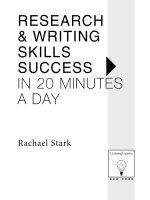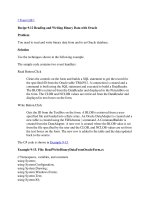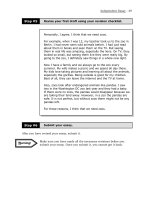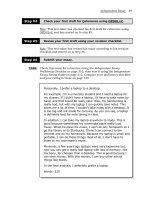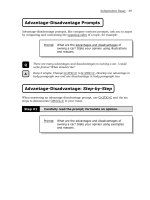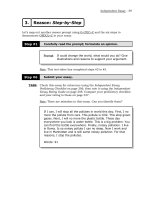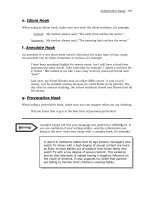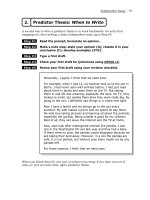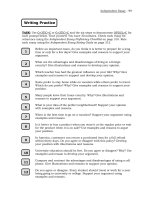Tài liệu RESEARCH AND WRITING SKILLS SUCCESS PART 10 pdf
Bạn đang xem bản rút gọn của tài liệu. Xem và tải ngay bản đầy đủ của tài liệu tại đây (78.09 KB, 7 trang )
Depending on the length of your paper,
you can also begin to approximate roughly
how long each section will be. If you are writ-
ing a paper for a specific class or the length has
been dictated to you in advance, then you can
revise your outline to reflect how many pages
you will write for each part of your paper. If
there is a specific length requirement, then,
based upon the volume of information you
have gathered and the total number of your
note cards, you can try to approximate its
length. Simply fill in the number of pages in
each section as you think they might be and
don’t worry about being exact yet. Remember,
you haven’t started to write. Some sections
may have more pages than you originally
intended and that’s fine. For the moment, just
guess. If your assignment was to write an 18-
page paper, your outline might be:
THESIS STATEMENT = [One sentence]
INTRODUCTION = [One page or two
paragraphs]
BODY
1) SECTION #1 = 5 pages
2) SECTION #2 = 5 pages
3) SECTION #3 = 5 pages
CONCLUSION = [Two pages]
Again, remember that this is not exact.
You might write a slightly longer introduction
or perhaps section three, the last part of your
paper, might be a little longer than the two
previous sections. This breakdown just pro-
vides you with another, more specific visual
guideline of how your paper will be struc-
tured.
Filling In Your Finalized
Outline
Now that you have a general blueprint handy,
it’s time to begin to fill in your outline with as
much specific information as possible so that
it can help you. For example, let’s return to the
topic of the assassination of President John F.
Kennedy. The most important part of any
paper (and sometimes the hardest) is your the-
sis statement. What are you trying to prove in
your paper? What has all your research and
evidence led you to conclude about the assas-
sination of President Kennedy? Perhaps you’ve
decided that the assassination of President
Kennedy was not a conspiracy or plot as some
of the reading suggested, but the work of a
lone assailant. Write in your idea at the top of
your outline. It’s best if you can try to word
your thesis statement or overall argument of
your paper as one sentence—two at the very
most. The more succinct you are and the more
you can condense your thoughts into a single,
powerful sentence, the easier it will be for your
readers to follow your argument. Now your
outline will look like this:
THESIS STATEMENT = President Kennedy’s
assassination was not the result of a conspira-
cy or specific plot, but the work of a lone,
angry assailant.
Again, you can change the wording of
your thesis statement later, but for now try to
express your idea so that you can write it at the
top of your outline. In this way, you can always
make sure that all your evidence, all your para-
graphs in the body of your paper and in the
– FINALIZING AN OUTLINE–
50
– FINALIZING AN OUTLINE–
51
conclusion, prove, relate to, or point back to
your thesis statement. That’s why it’s a good
idea to write it at the top of your outline.
Filling In Your Outline with
Specifics from Your Note
Cards
As you finalize your outline, the more concrete
you can be the better. You might want to write
your introduction now, even if it’s a very
rough draft. For the purposes of the outline,
try to keep your introduction to a paragraph
so that your entire outline can fit onto a single
sheet of paper (you can make it longer later).
The thesis statement and the introduction can
be the hardest parts of the paper to write
because it’s the first time you are actually put-
ting all your thoughts into words. But don’t
worry or be intimidated. Whatever you can
put down now will help you later on when you
finalize your last draft. After you write your
thesis statement and introductory paragraph,
you can fill in the three body sections.
Remember how you organized your note cards
in the last chapter? Write one topic sentence or
brief subject heading next to each section so
that your outline looks something like this:
SECTION #1 = President John F. Kennedy’s
first two years in politics and key political
actions and strategies that caused contro-
versy . . .
SECTION #2 = Reactions to President
Kennedy’s policies and specific opposition
from law makers and constituents . . .
SECTION #3 = Acts of sabotage and obstruc-
tion. Anger over Kennedy’s policies and how
this anger resulted in violence . . .
Again, as you start to write, you may
refine or narrow your sections, but these broad
topics will give you a solid basis for organizing
your paper. The last step you can take is to
refine your outline further. You can do this by
taking your note cards and arranging them in a
final order according to your section headings. In
other words, you have your sections clearly
divided, you know your thesis, what each sec-
tion will be attempting to prove and argue;
now all you need are the specific facts, data,
quotes, and statements—all of which are clear-
ly listed on your individual note cards.
To finish the outline, you might also want
to try to write down your conclusion.
Although most people wait until the actual
end of their paper to write their conclusion,
sometimes it helps to try to think ahead and
write what you will be summarizing. Just as
you did for your introduction, you can write a
very rough, preliminary paragraph, just so that
you get an idea of what your summary could
look like. In this way, your entire outline can
be organized and specific. You know about
how many pages each section will be, your
argument is concrete, and all your material is
there—ready to be linked together. In the next
chapter, we will discuss how to bundle the
material from your notes and form it into per-
suasive, analytical writing. Your entire outline
should fit neatly and easily onto a single sheet
of paper so that you do not have to go back
and forth between different sources or sift
through scraps of paper.
Summary
Keep your outline with you as you write and
refer to it constantly. Although it may change
once you begin writing, you will always have it
as a basic guideline and original map of your
thoughts. Remember, your outline is a starting
point and a solid, visual way to organize your
thoughts and sources. When you begin the
actual process of writing, you don’t have to
worry about how to organize your sources or
how they will all fit together.
– FINALIZING AN OUTLINE–
52
53
T
hink of your thesis statement as an explanation or a summary. If you have a question that
you want answered immediately, what kind of answer do you want to receive? Most peo-
ple like direct answers that are straightforward, do not mince words, and give them concrete
explanations. For instance, if you are a teacher and you ask your students if they have their
homework, you’d probably want to hear responses like, “Yes, it’s here in my desk,” or, “I’m sorry, I
don’t have it with me today.” What might make you frustrated, however—even more frustrated
than a student who doesn’t have his or her homework—is an answer like, “Uh, no, I’m sorry, my
homework isn’t here. You see, last night, my grandmother came to dinner, and because of traffic from
New Jersey she was late. It was weird because the traffic across the George Washington Bridge was
really bad last night because of an accident and by the time my grandmother came and we had all
finished dinner, I didn’t have time to really get to my homework. But etc.” In other words, the
more directly you can answer a question, and the fewer words you use, the better. In fact, it is
much more likely that people will believe you if you answer them quickly and directly without
LESSON
How to Write
a Thesis
LESSON SUMMARY
The most important part of your paper is your thesis statement.
Your entire paper, all the evidence you have accumulated, and the
style you choose to write in, will all support and defend this state-
ment. This lesson is about writing a strong thesis so that your
reader will be immediately convinced by your argument and point
of view.
10
drifting off the topic or avoiding the question.
The same holds true with formulating your
thesis statement. No matter how complex your
subject matter or your source may be, you
should be able to word your thesis in one sen-
tence or less. It may take some time and a little
bit of practice on your part, but if you have fun
and consider it an exercise, the careful and suc-
cinct wording of your thesis will save you
hours of valuable time later on.
Be Bold and Assertive
Usually, the most effective place for your the-
sis—where it makes the greatest impact upon
your reader—is at the beginning of your
paper. The thesis statement is always included
in the introductory paragraph so that the
reader is immediately drawn in and interested
in your writing. Some people like to begin a
paper using the thesis as the opening sentence.
Others like to write a few sentences and place
the thesis at the end of the introductory para-
graph. Either way is acceptable. Your writing
style and preference will dictate which of these
two methods you prefer, but to demonstrate
the difference that length makes, let’s consider
an example in which the thesis statement is the
very first sentence of your paper. Again, let’s
use the example of a paper on John F.
Kennedy’s assassination. Look at the two state-
ments below and determine which one most
powerfully hooks the reader:
Example A: This paper will discuss and
examine the assassination of President John F.
Kennedy. After doing a lot of research and
reading a lot of books, I have decided that
President Kennedy’s death was not the result
of a conspiracy, as many historians and most
people think. Actually, this paper will prove
that President Kennedy’s death was the work
of a lone gunman. It was not a government
conspiracy, although many people still believe
this.
Example B: Despite previous theories,
President Kennedy’s death was not the result
of a government conspiracy, but the work of
a lone assailant.
Which explanation or thesis statement
convinces you? Although both examples essen-
tially argue the same point, Example B is a
more persuasive thesis statement because it is
short, right to the point, and makes a bold,
declaratory statement. Even if the reader does-
n’t necessarily agree with your thesis state-
ment, your boldness and strong assertion are
sure to rouse curiosity and a desire to read
more.
Practice Makes Perfect
It is not always easy to consolidate and narrow
down the entire essence of your paper or your
research into a single sentence. But don’t
worry. Just as you allowed yourself to brain-
storm for your outline, take a blank sheet of
paper and write down a full, flowing, practice
paragraph that includes several sentences
about why you are writing your paper and why
you think the topic is important. This gives
you plenty of material to draw from and sen-
tences to edit that are already about your topic.
For example, a preliminary thesis paragraph
might look like this:
– HOW TO WRITE A THESIS–
54
Example A: I have always been interested in
the assassination of President John F.
Kennedy. Although I have read a lot of books
that discuss theories about his death being
the work of the Mafia, the CIA, or another
member of the government, it seems to me
like the best theory and the one which is most
believable is that he was killed by an assassin.
The plan was drawn over many months and
carried out to perfection.
Now that you have a lot of sentences to
work with, highlight information or words
that are important. Later, you have your entire
paper to explain your theories and detail your
research, but for the moment, try to connect
the two most important sentences together
and then narrow them down further or fuse
them into one sentence. If you were to high-
light the key or essential information in the
paragraph you wrote, the sentences or words
that you highlighted might look like this:
Example B: I have always been interested in
the assassination of President John F.
Kennedy. Although I have read a lot of books
that discuss theories about his death being
the work of a conspiracy like the Mafia, the
CIA, or another member of the government,
it seems to me like the best theory and the
one which is most believable is that he was
killed by an assassin. The plan was drawn
over many months and carried out to
perfection.
Practicing Your Thesis
Out Loud
If you are still having trouble narrowing your
ideas down on paper, another way to refine
your ideas is to practice saying your thesis out
loud to a friend or relative. A good way to
think of this is to pretend that you are a
Hollywood director and you are “pitching”
your film idea to an influential producer. If
you want a producer to invest millions of dol-
lars and make a big budget movie, you’ve got
to get him or her interested in your idea, or
“pitch,” immediately. As a writer, you are the
“director” of your paper and you’ve got to get
your “audience,” or reader, interested immedi-
ately. Most often, you will only have sixty sec-
onds to run your idea past a producer, so you
need to sum up your movie and your idea very
neatly and succinctly. Maybe you want Brad
Pitt or Julia Roberts to star in your movie, but
you are a newcomer to Hollywood and this is
your first movie. How would you convince a
producer to invest in your idea? Similarly, how
do you convince a reader to spend time read-
ing your paper? A powerful thesis statement
will do the trick. For example, if you say to the
Hollywood producer:
Example A: I’d like to make a film about for-
mer President John F. Kennedy. I have always
been interested in the former president
because of a high school teacher, Mr.
Golding, who was very influential in my
thinking. I remember Mr. Golding suggested
that there were many different theories
behind President Kennedy’s death, but after
we spent our term discussing it and after
many years of reading, I have decided etc.
– HOW TO WRITE A THESIS–
55
Are you still reading? Is the Hollywood
producer still listening? How about another
pitch that might say:
Example B: Many people believe that John F.
Kennedy’s death was the result of a conspir-
acy, but they are wrong. My film will drama-
tize his murder at the hands of a lone
assassin.
Again, even if the Hollywood producer
does not agree with you, he or she might be
intrigued by your theory. You haven’t taken up
all his or her time; you have been direct in your
wording and purpose; and he or she might be
willing to invest money in your idea. For fun,
consider your thesis to be a pitch. Pretend that
you only have a maximum of 60 seconds to
state your idea. Have a friend time you. If you
cannot summarize your thesis statement with-
in that time frame and you cannot narrow
down your thesis statement into one sentence,
odds are that you still need to rework it. The
more you practice, the easier it will become
and you will find yourself saying it out loud in
no time. Hearing your thoughts out loud is a
good way to recognize whether or not they
make sense. Many times, having a friend or
relative summarize your words will guide you
in this process.
Summary
Perfecting your thesis to make it as convincing
and succinct as possible is important.
Although it might take a little bit of practice
before you are able to narrow down your
thoughts and condense your thesis into a sin-
gle sentence, a short, strong thesis statement
will save you a lot of time later on. A bold dec-
laration at the beginning of your paper assures
your reader that you are in control of your
material.
– HOW TO WRITE A THESIS–
56
